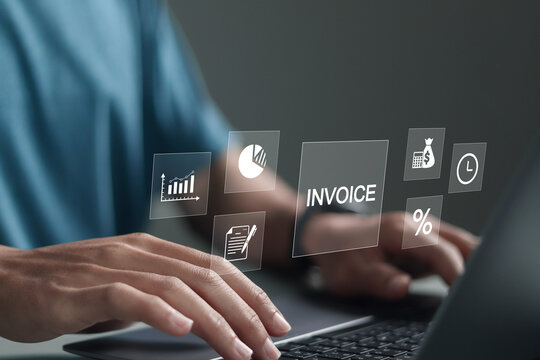E-Invoicing: Revolutionizing Business Transactions in the Digital Economy
In today’s fast-paced digital economy, businesses are continually seeking ways to enhance efficiency and streamline operations. One of the most transformative innovations in this realm is e-invoicing, a digital alternative to traditional paper invoicing. So, what is e-invoicing? At its core, e-invoicing refers to the electronic delivery of invoices, allowing for quicker processing, improved accuracy, and better cash flow management. As companies navigate the complexities of financial transactions, the benefits of e-invoicing become increasingly clear.
E-invoicing is more than just a trend; it is rapidly becoming an essential component of modern business practices. By adopting e-invoicing systems, organizations can automate tedious manual processes, reducing the risk of human error while significantly speeding up invoice processing times. This transition not only saves valuable time but also ensures that businesses can manage their cash flow more effectively, leading to a healthier bottom line.
In this comprehensive e-invoicing guide, we will explore the myriad benefits of e-invoicing, from enhanced accuracy in billing to improved operational efficiency. Whether you’re a small business owner, freelancer, or part of a larger organization, understanding how e-invoicing can transform your invoicing processes is crucial. Join us as we delve into the essential aspects of e-invoicing and discover how it can elevate your business to new heights in the digital landscape.
What Is E-Invoicing?
E-invoicing, or electronic invoicing, refers to the process of sending, receiving, and processing invoices in a digital format rather than relying on traditional paper invoices. This innovative method allows businesses to streamline their invoicing processes, enhance accuracy, and improve overall efficiency. Unlike conventional invoicing, which can be prone to delays and errors due to manual handling, e-invoicing automates these tasks, significantly reducing the chances of mistakes and ensuring faster payment cycles.
There are several formats in which e-invoices can be generated and transmitted, each catering to different business needs. Common formats include PDF, which is widely used for its compatibility across various platforms and ease of viewing, and XML, which allows for more structured data exchange and is often utilized in automated systems. Other formats such as CSV and EDI (Electronic Data Interchange) are also prevalent, depending on the complexity of the business transaction. Each format has its advantages, with PDF being more user-friendly and XML providing greater data integration capabilities.
Electronic Data Interchange (EDI) plays a crucial role in the realm of e-invoicing by enabling the seamless exchange of business documents between trading partners. EDI allows organizations to communicate invoice data in a standardized electronic format, facilitating faster processing and reducing the need for manual data entry. By using EDI, businesses can automate the invoicing process from order to payment, ensuring that all relevant information is accurately captured and transmitted without the typical bottlenecks associated with paper-based methods.
In summary, the definition of e-invoicing encompasses a range of electronic methods for invoicing that are distinctly different from traditional approaches. By understanding the various types of e-invoices and the integral role of EDI, businesses can leverage e-invoicing to optimize their financial processes and thrive in today’s digital landscape.
How Does E-Invoicing Work?
Understanding how e-invoicing works is essential for businesses looking to optimize their invoicing processes. The e-invoicing process typically involves four key steps: creation, transmission, receipt, and processing, followed by integration with accounting systems.
First, the creation of an e-invoice occurs when a seller generates an invoice using accounting software or an e-invoicing platform. This software allows users to input all necessary transaction details, such as item descriptions, quantities, prices, and payment terms. The resulting e-invoice can be formatted in various ways, such as PDF, XML, or EDI, depending on the preferences of the sender and recipient.
Once the e-invoice is created, it is transmitted to the recipient. This transmission can occur through various channels, including email, secure portals, or direct integration with the recipient’s accounting system. The choice of transmission method often depends on the technology used by both parties and their specific needs for security and efficiency.
Upon receipt, the client processes the e-invoice. Most modern accounting systems can automatically recognize and extract relevant information from e-invoices, eliminating the need for manual data entry. This capability not only speeds up processing times but also reduces the likelihood of errors associated with traditional paper invoices. Once the invoice is verified and approved, it can then be scheduled for payment, ensuring a smoother cash flow process.
Finally, e-invoicing seamlessly integrates with existing accounting systems, allowing for real-time tracking and management of invoices. This integration ensures that all financial data is up-to-date, providing businesses with a clear picture of their cash flow and outstanding receivables.
Automated systems play a vital role in facilitating the e-invoicing process. They enable businesses to automate repetitive tasks, such as invoice generation and data entry, which not only increases efficiency but also minimizes human error. By leveraging automation, organizations can streamline their e-invoice workflow, resulting in faster payments, improved accuracy, and enhanced overall financial management.
Benefits of E-Invoicing
E-invoicing has rapidly gained traction as businesses seek more efficient ways to manage their invoicing processes. The benefits of e-invoicing extend far beyond mere convenience; they fundamentally transform the way organizations handle their financial transactions. Below are some of the key advantages of adopting e-invoicing, supported by statistics and case studies that illustrate its impact.
- Improved Accuracy and Reduced Errors
One of the most significant advantages of e-invoicing is its ability to enhance accuracy and minimize errors. Traditional paper invoicing is prone to mistakes, whether from manual data entry, miscommunication, or lost documents. E-invoicing automates the data entry process, allowing invoices to be generated directly from accounting systems. According to a study by Billentis, organizations using e-invoicing report error rates that are 50% lower than those relying on manual processes. This reduction in errors not only saves time but also fosters trust between trading partners.
- Faster Processing and Payment Times
E-invoicing dramatically accelerates the invoicing workflow, leading to quicker processing and payment times. With traditional methods, invoices can take weeks to be approved and paid. However, e-invoicing allows for real-time processing, enabling companies to receive payments in a fraction of the time. A case study by Ariba revealed that companies adopting e-invoicing reduced their invoice processing times by up to 75%. This swift payment cycle helps businesses maintain a healthier cash flow and improve vendor relationships.
- Cost Savings on Paper and Postage
Transitioning to e-invoicing results in significant cost savings. Traditional invoicing involves expenses related to printing, paper, postage, and storage. A report from PayStream Advisors found that organizations could save an average of $3 to $5 per invoice by implementing e-invoicing. These savings can accumulate quickly, especially for businesses with high invoice volumes. For example, a company sending 1,000 invoices per month could potentially save thousands annually by going paperless.
- Enhanced Cash Flow Management
E-invoicing also improves cash flow management by providing businesses with better visibility into their outstanding receivables. With automated invoicing systems, companies can easily track invoice statuses, payment timelines, and outstanding balances. This capability enables organizations to forecast cash flow more accurately and take proactive measures to address any potential shortfalls. A study by the Aberdeen Group found that businesses using e-invoicing experience a 60% improvement in cash flow management compared to those relying on traditional methods.
- Better Tracking and Reporting Capabilities
The digital nature of e-invoicing allows for advanced tracking and reporting capabilities that traditional methods simply cannot match. Businesses can generate real-time reports on invoice statuses, payment histories, and discrepancies, facilitating informed decision-making. E-invoicing solutions often come with built-in analytics tools that help organizations identify trends and patterns in their invoicing processes, leading to further optimization. For instance, a case study involving a large retail chain showed that their implementation of e-invoicing resulted in a 25% increase in financial reporting accuracy.
Challenges of E-Invoicing
While e-invoicing offers numerous advantages, businesses may encounter several challenges during its implementation. Recognizing these e-invoicing difficulties is crucial for ensuring a smooth transition. Here are some of the common obstacles companies face, along with tips for mitigating them.
- Initial Setup Costs
One of the primary challenges of e-invoicing is the initial setup cost associated with adopting new technology. Businesses may need to invest in software, hardware, and training for staff, which can be a significant financial burden, especially for small to medium-sized enterprises. To address this challenge, companies should conduct a thorough cost-benefit analysis before implementation. Exploring cloud-based e-invoicing solutions can also help minimize upfront costs, as many of these services operate on a subscription model, allowing for more manageable ongoing expenses.
- Resistance to Change from Traditional Methods
Resistance to change is a common obstacle when transitioning to e-invoicing. Employees accustomed to traditional invoicing methods may be hesitant to adopt new processes, fearing that they will disrupt established workflows. To ease this transition, organizations should prioritize employee training and communication. Providing comprehensive training sessions that demonstrate the benefits of e-invoicing – such as increased efficiency and reduced manual errors – can help gain buy-in from staff. Involving employees in the decision-making process can also foster a sense of ownership and lessen resistance.
- Integration Issues with Existing Systems
Integrating e-invoicing solutions with existing accounting and enterprise resource planning (ERP) systems can pose significant challenges. Compatibility issues may arise, resulting in data silos or operational inefficiencies. To mitigate integration issues, businesses should thoroughly research e-invoicing solutions that offer compatibility with their current systems. Engaging with IT specialists or vendors who can provide custom integration support can also ease the transition and ensure a seamless flow of information.
- Compliance with Regulations and Standards
Another challenge lies in ensuring compliance with various regulations and standards related to e-invoicing. Different regions may have specific legal requirements regarding digital invoicing, and failing to comply can lead to costly penalties. To navigate this complexity, companies should stay informed about applicable regulations and engage legal counsel or compliance experts during the implementation process. Many e-invoicing solutions are designed to adhere to industry standards, so choosing a reputable vendor can also help ensure compliance.
How to Create E-Invoices
Creating e-invoices is a straightforward process that can significantly enhance your billing efficiency. Here’s a step-by-step guide on how to create e-invoices, complete with essential tips for best practices.
Step 1: Select E-Invoicing Software or Platforms
The first step in creating e-invoices is to choose the right e-invoicing software or platform. There are numerous options available, ranging from standalone invoicing tools to comprehensive accounting software that includes e-invoicing capabilities. Consider your business’s specific needs, such as budget, scalability, and ease of use. Popular options include Vantazo, FreshBooks, and Zoho Invoice. Many of these platforms offer free trials, allowing you to test functionality before committing.
Step 2: Set Up Templates
Once you’ve selected your e-invoicing software, the next step is to set up invoice templates that align with your business needs. A good template should be customizable, allowing you to incorporate your branding elements like your logo, colors, and fonts. Ensure that your template is professional and easy to read, as this reflects your business’s credibility. Most e-invoicing platforms provide customizable templates, so take advantage of these features to create a unique invoice design that suits your style.
Step 3: Include Essential Information
When creating an e-invoice, it’s crucial to include all essential information to avoid confusion and ensure timely payments. Your invoice should contain the following details:
- Your Business Information: Include your business name, address, phone number, and email.
- Client Information: Clearly list your client’s name, address, and contact information.
- Invoice Number: Assign a unique invoice number for tracking purposes.
- Invoice Date: Indicate the date the invoice is issued.
- Due Date: Specify the payment due date to encourage timely payments.
- Items and Pricing: Detail the products or services provided, including quantities, descriptions, unit prices, and any applicable taxes.
- Payment Terms: Clearly outline your payment terms, including accepted payment methods.
By providing all necessary information, you reduce the likelihood of disputes or delays in payment.
Step 4: Test the E-Invoicing System for Accuracy
Before sending out your first e-invoice, it’s essential to test the system to ensure everything functions smoothly. Generate a few test invoices using dummy data to verify that all information is correctly displayed and calculations are accurate. Review the layout and formatting to confirm that it appears professional and meets your standards.
Best Practices for E-Invoicing
To maximize the effectiveness of your e-invoicing process, consider the following best practices:
- Keep It Simple: Use clear language and avoid jargon. A straightforward approach ensures your clients understand the invoice details easily.
- Automate Reminders: Utilize your e-invoicing software to set up automated payment reminders to prompt clients about upcoming due dates.
- Maintain Records: Keep a digital record of all sent invoices and related correspondence for easy reference and tracking.
- Follow Up: If payments are late, don’t hesitate to follow up with clients to address any concerns and facilitate resolution.
Key Takeaways
E-invoicing is a transformative approach to managing business transactions in the digital economy. Throughout this article, we have explored the definition of e-invoicing, its operational process, and its many benefits, including improved accuracy, faster processing times, cost savings, enhanced cash flow management, and better tracking capabilities. By automating invoicing, businesses can significantly reduce errors and streamline their financial operations, ultimately leading to a more efficient workflow.
Adopting e-invoicing is no longer just a trend; it is an essential strategy for modern businesses looking to maintain a competitive edge. The challenges associated with transitioning to e-invoicing can be effectively managed with careful planning and the right software solutions. By making this transition, businesses can enhance their invoicing processes, foster better relationships with clients, and optimize their cash flow.
As you consider the future of your business, we encourage you to explore the benefits of transitioning to e-invoicing. Embracing this technology can significantly enhance your operational efficiency and position your business for success in a rapidly evolving digital landscape.
Frequently Asked Questions
Is e-invoicing legally binding?
Yes, e-invoicing is legally binding as long as it meets the requirements set forth by relevant laws and regulations. In many jurisdictions, electronic invoices are recognized as valid financial documents, provided they contain the necessary information and comply with local legal standards.
How does e-invoicing comply with tax regulations?
E-invoicing can comply with tax regulations by ensuring that invoices include all required tax information, such as tax identification numbers and applicable tax rates. Many e-invoicing platforms are designed to adhere to specific tax compliance standards, automating the process to ensure accurate reporting and adherence to local tax laws.
What software is best for e-invoicing?
The best e-invoicing software depends on your business needs. Popular options include Vantazo, FreshBooks, and Zoho Invoice, which offer user-friendly interfaces and robust features. When choosing software, consider factors such as integration capabilities, scalability, customer support, and pricing to find the solution that best fits your organization.
These answers to common e-invoicing questions should help clarify any uncertainties and guide you in making informed decisions about your invoicing processes. If you have further inquiries, feel free to seek additional e-invoicing help or consult with professionals in the field.



